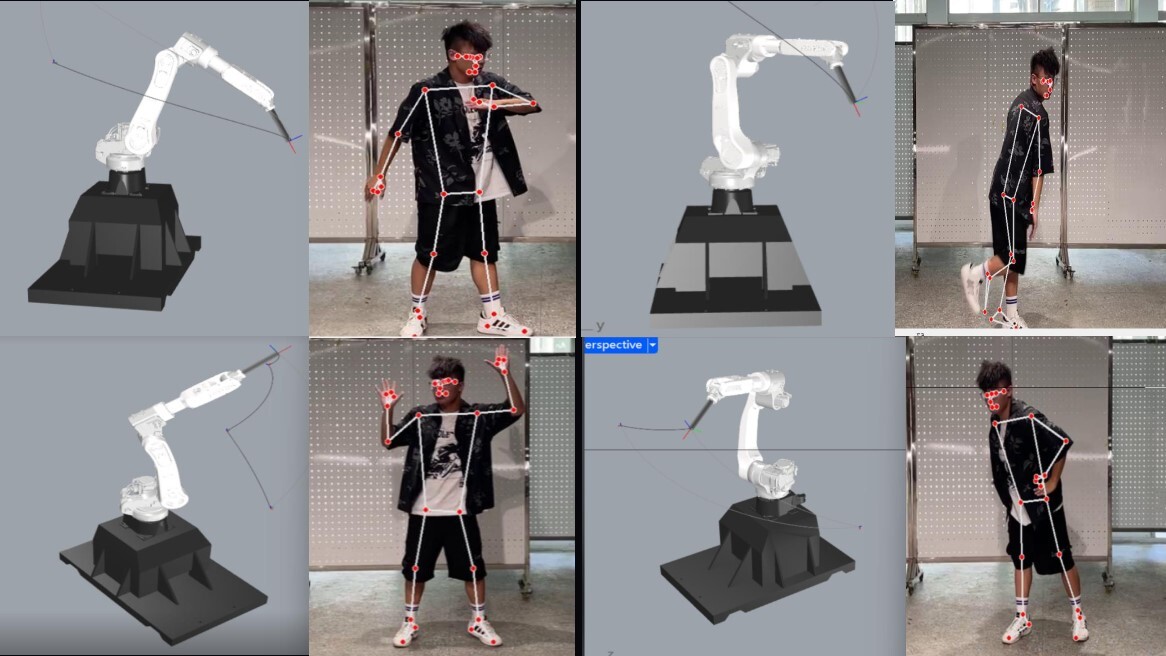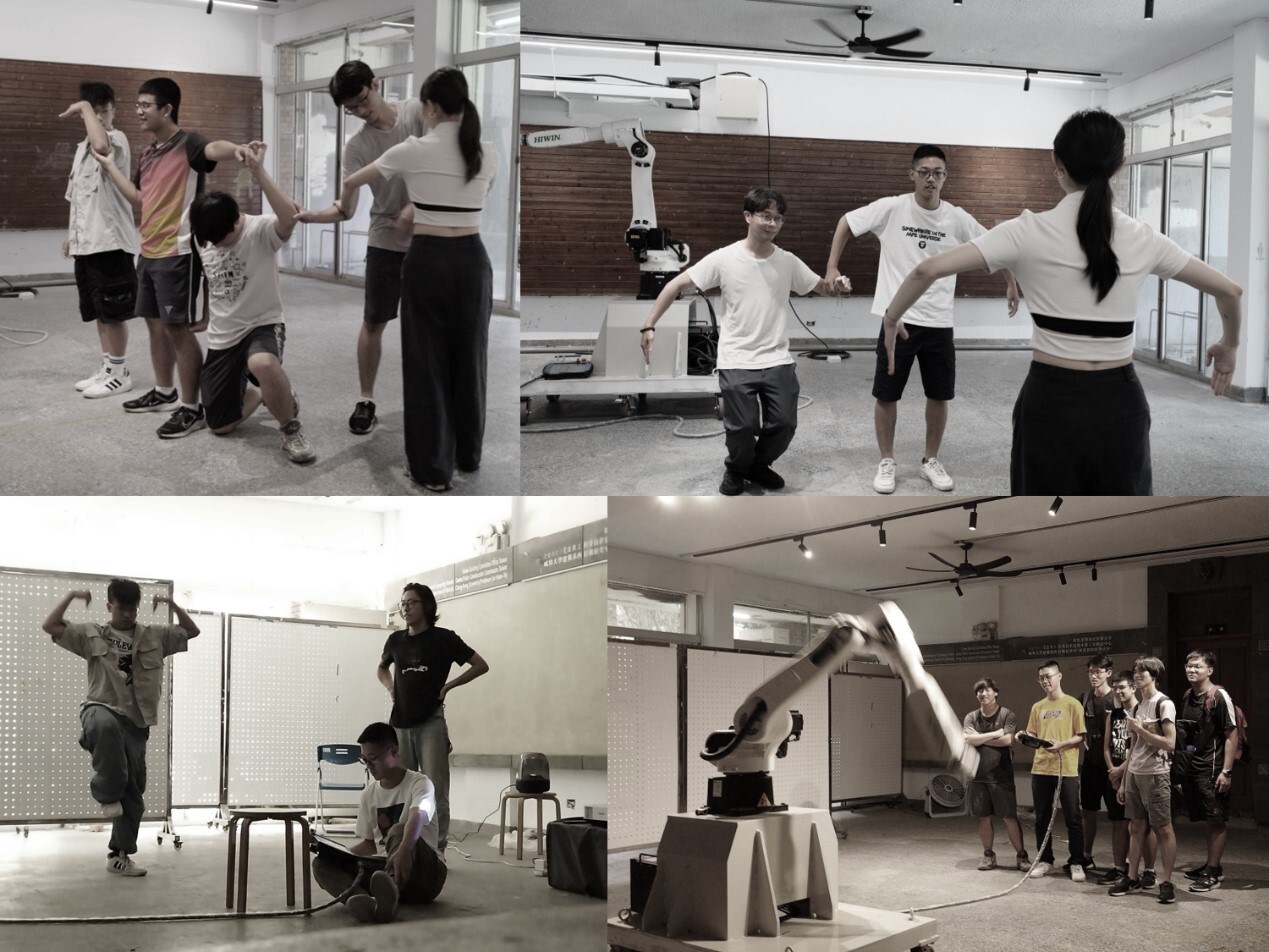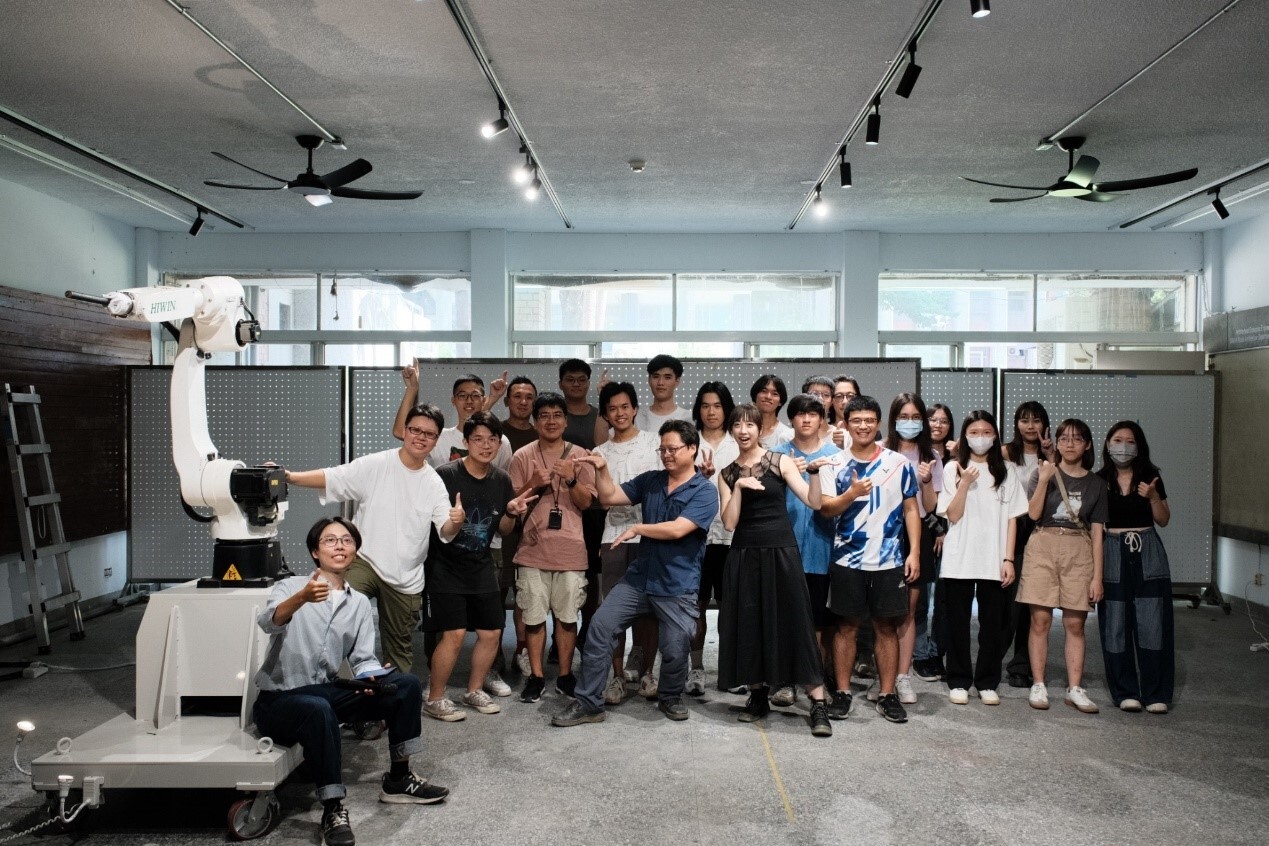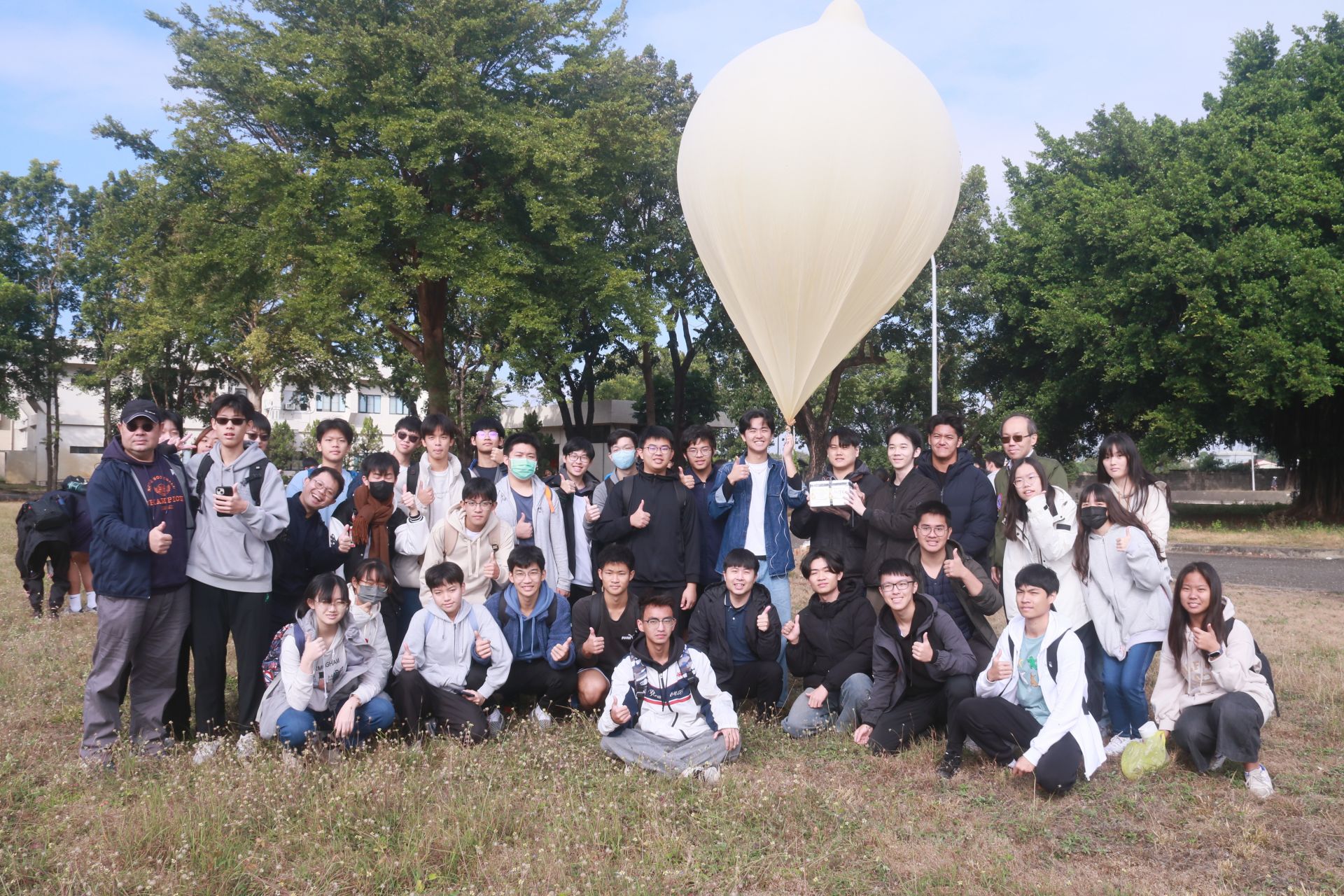SDG4
NCKU’s General Education Modular Course Leads Interdisciplinary Students to Co-Create Tech-Art Dances with Robotic Arms
Can one course turn you into a choreographer of techno-art? What seemed like an impossible task was accomplished by a group of students and faculty at National Cheng Kung University (NCKU) in just five days. Professor Yang-Ting Shen from the Department of Architecture at NCKU launched the techno-art practical course titled "Dancing with Robot: Interdisciplinary Integration of Robotic Arm and Techno Art" through the General Education Center's summer modular program. This course, with the theme "Dancing with Robots," connected skeletal recognition technology with the forward kinematic control of robotic arms in just five days, enabling students to teach the robotic arms to dance through body language. It shattered stereotypes about the application of robotic arms, transforming them into a new medium for techno-art by combining them with dance.
The "Dancing with Robots" course originated two years ago from a project funded by the National Science and Technology Council, led by Dean Chien-Hsu Chen of NCKU's College of Planning and Design, titled "Island Interpretation: Translating Techno-Art Spaces and Co-Creating Cross-Domain Dance - Using Matsu as a Practical Base." Throughout its two-year development, the project collaborated with director Chieh-Hua Hsieh and dancer Yu-Xuan Yeh from Anarchy Dance Theatre, abandoning the traditional complex programming methods for controlling robotic arms. Instead, it used body movements as a new control interface. This allowed choreographers to intuitively and naturally control the robotic arms, which, after being translated through skeletal recognition technology, could replicate continuous movements. In this way, robotic arms were no longer just rigid tools for manufacturing but became creative partners capable of dancing alongside performers.
After two years of research and development in the "Island Interpretation" project and the 2024 performance of "Dancing with Robots: Traces" at the Kaohsiung Museum of Fine Arts, project members Professor Yang-Ting Shen and Ph.D. candidate Mi-Chi Wang envisioned promoting this newly developed techno-art to a broader audience and integrating it into education. With support from the General Education Center, they launched the techno-art practical modular course "Dancing with Robots: Interdisciplinary Integration of Robotic Arm and Techno Art" in the summer of 2024.
The "Dancing with Robots" modular course emphasizes three key features: modular teaching, interdisciplinary learning, and project-based outcomes. The five-day modular format packaged various technical skills into agile modules, reducing the technical burden on participants and encouraging them to focus on dance creation. The course attracted a diverse group of students from disciplines including mechanical engineering, electrical engineering, computer science, hydraulics, geosciences, business administration, architecture, and techno-art, even drawing faculty and students from NTU's Department of Drama to observe. Teams were formed by mixing students from different fields, fostering diverse interdisciplinary collaboration. The course outcomes were not graded solely on academic performance but were project-oriented, with each team tasked with creating a three-minute human-robot dance as their final project. This approach allowed participants to understand and apply what they had learned while stimulating their potential for interdisciplinary cooperation.
In addition to teaching the core technique of controlling robotic arms through skeletal recognition, the course also invited dance artist Yu-Xuan Yeh to guide students in thinking about dance creation, especially how to translate dance movements into robotic arm gestures. The final presentations took place at the small amphitheater of the Department of Architecture, with dance artist Heng Wang serving as an external evaluator. Each group presented their creative concepts and technical details, followed by a three-minute human-robot dance performance. The themes were highly creative and demonstrated the achievements of five days of interdisciplinary collaboration.
The performance themes included:
The "Dancing with Robots" course originated two years ago from a project funded by the National Science and Technology Council, led by Dean Chien-Hsu Chen of NCKU's College of Planning and Design, titled "Island Interpretation: Translating Techno-Art Spaces and Co-Creating Cross-Domain Dance - Using Matsu as a Practical Base." Throughout its two-year development, the project collaborated with director Chieh-Hua Hsieh and dancer Yu-Xuan Yeh from Anarchy Dance Theatre, abandoning the traditional complex programming methods for controlling robotic arms. Instead, it used body movements as a new control interface. This allowed choreographers to intuitively and naturally control the robotic arms, which, after being translated through skeletal recognition technology, could replicate continuous movements. In this way, robotic arms were no longer just rigid tools for manufacturing but became creative partners capable of dancing alongside performers.
After two years of research and development in the "Island Interpretation" project and the 2024 performance of "Dancing with Robots: Traces" at the Kaohsiung Museum of Fine Arts, project members Professor Yang-Ting Shen and Ph.D. candidate Mi-Chi Wang envisioned promoting this newly developed techno-art to a broader audience and integrating it into education. With support from the General Education Center, they launched the techno-art practical modular course "Dancing with Robots: Interdisciplinary Integration of Robotic Arm and Techno Art" in the summer of 2024.
The "Dancing with Robots" modular course emphasizes three key features: modular teaching, interdisciplinary learning, and project-based outcomes. The five-day modular format packaged various technical skills into agile modules, reducing the technical burden on participants and encouraging them to focus on dance creation. The course attracted a diverse group of students from disciplines including mechanical engineering, electrical engineering, computer science, hydraulics, geosciences, business administration, architecture, and techno-art, even drawing faculty and students from NTU's Department of Drama to observe. Teams were formed by mixing students from different fields, fostering diverse interdisciplinary collaboration. The course outcomes were not graded solely on academic performance but were project-oriented, with each team tasked with creating a three-minute human-robot dance as their final project. This approach allowed participants to understand and apply what they had learned while stimulating their potential for interdisciplinary cooperation.
In addition to teaching the core technique of controlling robotic arms through skeletal recognition, the course also invited dance artist Yu-Xuan Yeh to guide students in thinking about dance creation, especially how to translate dance movements into robotic arm gestures. The final presentations took place at the small amphitheater of the Department of Architecture, with dance artist Heng Wang serving as an external evaluator. Each group presented their creative concepts and technical details, followed by a three-minute human-robot dance performance. The themes were highly creative and demonstrated the achievements of five days of interdisciplinary collaboration.
The performance themes included:
1. "Between the Rain and Sky" – The robotic arm mirrored the dancer's crossing hand gestures through lateral swinging movements.
2. "The Spark of Robotic Arm and Popping" – The arm's sharp, linear movements and sudden stops reflected the explosive muscle contractions and releases typical of popping dance.
3. "Intelligent Movement" – With large, smooth sweeping motions and fins attached to the arm's end, the arm mimicked the graceful movements of a shark gliding through the ocean.
4. "Hey, Classmate!" – The robotic arm performed rhythmic gymnastics, creating an atmosphere of human-robot sing-along interaction.
5. "OANA" – The arm's interaction with hand gestures, forming shadow images like traditional shadow puppetry, became a new medium for techno-art expression.
Heng Wang, who was invited as a guest evaluator, praised the interdisciplinary modular course for giving students the opportunity to engage in performing arts and interdisciplinary collaboration. She was impressed by the students' ability to complete a techno-art human-robot dance in just five days and hoped that this experience would ignite a passion for techno-art and interdisciplinary cooperation. Ph.D. candidate Mi-Chi Wang, a technical instructor, mentioned that the course intentionally minimized programming and theoretical lectures, focusing instead on technical integration and application. Using a project-based approach, students from different departments collaborated to create human-robot dances. Surprisingly, many of the participants came from engineering backgrounds and had little exposure to the arts. However, by the end of the five-day course, they had transitioned from being uncertain about art and dance to successfully interpreting the fusion of technology and art through their human-robot dances, achieving personal breakthroughs. The course, unified by dance, showed that "the distance between my technology and your art is only one dance away!"

Professor Yang-Ting Shen from NCKU’s Department of Architecture launched the techno-art practical course "Dancing with Robot: Interdisciplinary Integration of Robotic Arm and Techno Art" through the General Education Center's summer modular program.

Transforming body movements into robotic arm actions through skeletal recognition.

The process of students creating dance.

Group photo of all students and faculty.

SDG42024 NCKU Science Education Center High School Teacher Workshop receives enthusiastic support from teachers across Taiwan.
View more
SDG4NCKU Institute of Space Systems Engineering Launches Exciting Weather Balloon Mission with Interdisciplinary Collaboration
View more



















